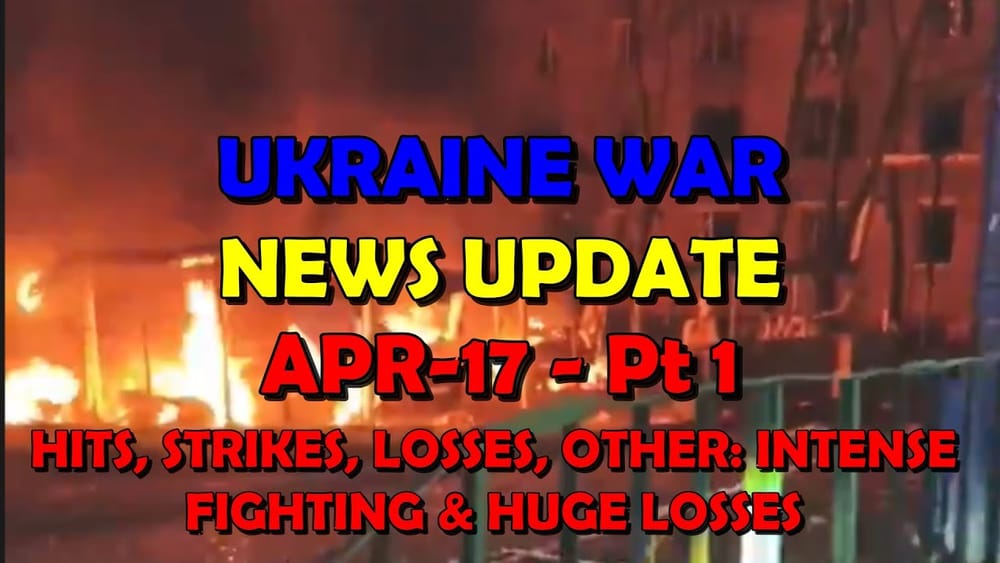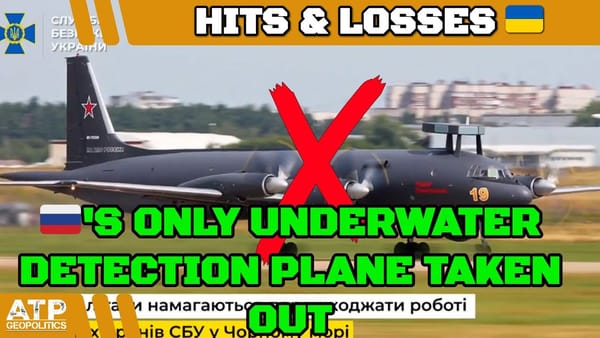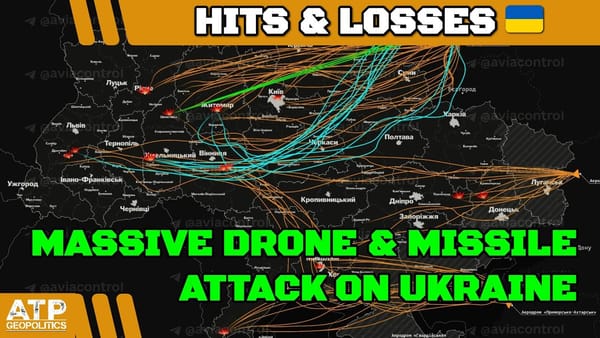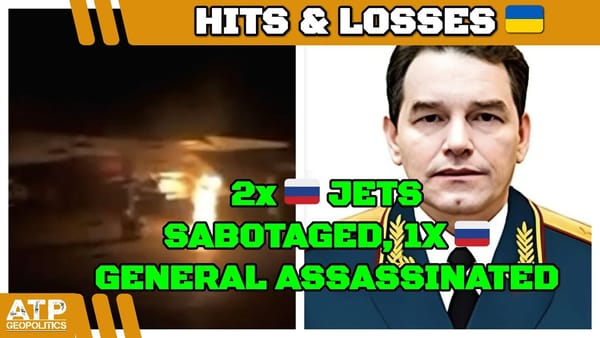Ukraine War Update: Pt 1 - Overnight & Other News - More Revenge for Sumy
Table of Contents 📖
"Tea is the drink of the secular gods, not coffee. It's always tea."
Hello Team
🎦 00:00-00:16⏩
- Jonathan welcomes viewers to ATP Geopolitics and this Ukraine War News Update, the first part for 17th April 2025.
- He jokes about getting the date right and takes a "congratulatory gulp of tea" to start the video.
🪦 DISCLAIMER FOR GENERAL STAFF LOSSES DATA
- These are real people with real lives and real families who love them. Don’t let the numbers sap your humanity.
- These numbers probably aren’t accurate but they’re the best we have and we don’t need them to be accurate to be indicative of patterns of activity.
- All losses are estimates. Losses cannot be counted with accuracy because of the conditions on the ground.
- Both sides would see it to be of their advantage to minimize their own losses maximize the other side’s losses.
- Neither side releases their losses but we have enough transparency from the Ukrainian side to have confidence in they are indicative.
- Personnel losses are hard to count. If a soldier gets injured, heals up, and returns to the front line only to get injured again, is that one loss or two? Also, how to deal with losses from PMC’s or soldiers fighting with RF from occupied territories?
- Equipment losses are hard to count. If an AA complex involves several parts and one part gets disabled, is that a loss, or a fraction of a loss? If a tank gets disabled, repaired, back into the fight, then disabled again, is that one lost tank or two?
- All recorded losses are vulnerable to multiple reporting. We have already seen numerous cases of multiple drones in the air reporting the same loss from different angles as multiple engagements.
- Losses are not always reported on the same day they occurred. It is frequent that drone losses are reported at least 24 hours after other terrestrial equipment losses. Certain losses may not be reported for days or weeks for military intelligence reasons.
Ukrainian General Staff report 1,230 Russian personnel, 16 tanks and 65 artillery pieces lost
🎦 00:19-02:02⏩
- Jonathan reviews the Ukrainian General Staff figures for Russian losses, reminding viewers the figures are linked in the description.
- Personnel losses: 1,230, an increase from yesterday's 1,050, back to the usual high levels.
- Tank losses: 16, higher than average.
- AFV losses: 54, over double the daily average.
- Artillery pieces losses: 65, nearly triple the daily average.
- Other losses: 2 MLRS, 3 anti-aircraft warfare systems, 170 vehicles and fuel tanks, 3 pieces of special equipment.
- Jonathan notes these are high losses for the Russians, indicating heavy fighting and attack from their side.
- He reiterates that "vehicles and fuel tanks" include various non-military vehicles being used as combat assets and will show video evidence later.
- Personnel losses are near 1,300 which is considered a bad day for Russia, as they consistently lose over 1,000 personnel daily.
Minimum 102,000 Russian deaths confirmed by BBC Russia and Mediazona, Russia's birth rate falls to 200-year low
🎦 02:02-04:28⏩
- Jonathan cites BBC Russia and Mediazona, who compile Russian death data from obituaries and social media, as reporting a minimum of 102,000 Russian deaths.
- This figure excludes deaths from DPR and LPR units and is a very conservative minimum estimate.
- He contrasts this with Ukrainian General Staff figures of 937,440 total Russian losses (including dead, wounded, POWs, and deserted).
- While the exact death toll within the Ukrainian figure is unknown, estimates range around 200,000-250,000.
- The 102,000 figure from BBC Russia and Mediazona is a solid minimum starting point, and likely much higher when including DPR/LPR and unreported deaths.
- Jonathan highlights footage from Bashkortostan showing numerous coffins arriving from Ukraine, illustrating the war's impact on Russia.
- He connects this to news of Russia's birth rate falling to a 200-year low, indicating long-term demographic problems exacerbated by the war.
- Jonathan states Russia is in "trouble" and facing demographic decline while losing many men in Ukraine, with 102,000 deaths being a minimum.
Russia increases conscription to 160,000; Andrew Perpetua discusses Belgorod and Kursk terrain
🎦 04:42-06:17⏩
- Jonathan discusses Russia's annual conscription, increased from 120,000 to 160,000, but clarifies this isn't mobilization for the front lines, but national service within Russia.
- These conscripts are meant to stay in Russia, but the Russian army will try to pressure them into becoming contract soldiers for frontline deployment.
- Conscripts could be used in border regions like Kursk and Belgorod, where Ukrainian forces have entered.
- Jonathan mentions Andrew Perpetua's surprise appearance on his previous livestream, where they discussed the Belgorod region.
- He notes that Andrew described the terrain around Kursk as very defensible for Ukrainians, making Russian advances difficult.
- In Belgorod, specifically around Popivka and Demidovka, Andrew highlighted the limited road access and challenging terrain for Russian reinforcements, especially due to Ukrainian drone fire control.
Belgorod terrain difficult for Russian advance and 'road of death' for reinforcements
🎦 06:17-07:56⏩
- Jonathan refers to a "road of death" video from the previous day showing destroyed Russian vehicles on a road in the Belgorod region.
- He reiterates Andrew Perpetua's point that reinforcing areas like Demidovka and Popivka is a "nightmare" for Russians due to limited sensible roads and Ukrainian drone fire.
- Many roads are just farm tracks unsuitable for military vehicles, and any attempts to use the main roads are under constant drone and artillery fire.
Ukrainian drones target Russian supply roads in Belgorod and Kursk
🎦 07:56-09:58⏩
- Jonathan explains the effectiveness of Ukrainian drone teams targeting the main supply roads in Belgorod and Kursk regions.
- He uses a map to illustrate how drone teams, even positioned just across the border in Ukraine, can easily target Russian supply routes due to the short distance (around 10-11km).
- He mentions reports of five Kamaz trucks with 60 conscripts being destroyed in the Belgorod region, highlighting the success of this tactic.
- He compares this to the earlier situation in Kursk where Ukrainians faced similar supply route issues and losses due to Russian fire control on the main road into Sumy.
- The narrow bridgehead and limited access make supply routes vulnerable to drone attacks.
Russian assault near Prokrosk fails; tanks stuck, infantry on vans suffer losses
🎦 09:58-11:41⏩
- Jonathan notes increased footage emerging from the frontlines, possibly due to improved weather or intensified Russian attacks.
- He reports on a Russian attempt to storm the 59th Motorized Brigade near Prokrosk, involving tanks, trucks and infantry.
- The tanks reportedly got stuck near Seladove, which is located south of Prokrosk, quite far from the current frontline.
- He speculates the tanks may have been stuck further back while infantry was sent forward in vans and "larders" (likely Lada cars), resulting in predictable losses during another failed assault.
- This reinforces the earlier point about "vehicles and fuel tanks" losses including non-military vehicles used as combat assets by the Russians.
Ukraine's 71st Jäger Brigade repels Russian mechanized assault near Velika Novosilka
🎦 11:41-13:01⏩
- Jonathan cites footage of Ukraine's 71st Jäger Brigade repelling a mass Russian mechanized assault, possibly on the Velika Novosilka axis.
- Russia has restarted using large mechanized columns.
- Velika Novosilka is located further south, and there is significant fighting in that area.
- He mentions more footage of equipment being hit in this sector, but the outcome of the specific assault is unknown.
Russian mechanized assault near Robotina destroyed; survivors 'finished off'
🎦 13:01-13:30⏩
- On the Zaporizhzhia front, Russian forces launched a mechanized assault with 12 armoured vehicles and two companies towards Kapani-Robotyna.
- Robotyna is located further west on the map.
- It is claimed that all 12 vehicles were destroyed at the start of the assault.
- Surviving Russian infantry dismounted and were reportedly being "finished off".
- Lieutenant Alex reported that this probe of the line ended "very badly".
Russian attacks in Andreevka direction completely fail; vehicles destroyed
🎦 13:30-14:51⏩
- Jonathan refers back to his conversation with Andrew Perpetua, who mentioned attacks in the Andreevka direction, located west of Robotyna.
- A large Russian column attack in Andreevka was reportedly destroyed completely before reaching its objective.
- Every vehicle was destroyed in this failed attack.
- Andrew Perpetua noted that many Russian attacks fail to even get close to their targets and are completely destroyed.
- This is corroborated by the claim of 12 vehicles destroyed in Robotyna.
Large-scale Russian assault in Southern Ukraine repelled; heavy equipment losses
🎦 14:51-16:22⏩
- Jonathan reports on a large-scale Russian assault in southern Ukraine involving approximately 320 troops, 40 armoured vehicles, 3 tanks, and 10 buggies.
- The presence of 10 buggies again highlights the use of non-standard vehicles as "combat assets".
- Ukrainian defenders used drones and artillery to attack the assault force.
- After a two-hour battle, it is claimed that 29 vehicles and 140 Russians were destroyed, with no Ukrainian positions lost.
- Jonathan notes that footage of this attack exists but he cannot show it due to YouTube restrictions on his content, as his videos are consistently being flagged and restricted.
Attrition warfare strategy discussed; Ukraine's Kursk offensive losses highlighted
🎦 16:22-17:45⏩
- Jonathan summarises Andrew Perpetua's upbeat assessment, stating that Russians are "really suffering" phenomenal losses in personnel and equipment, with low morale and no ability to make significant gains.
- He discusses the strategy of "active defence" where Ukrainians attrit Russian forces by letting them attack, arguing it might be more effective than large Ukrainian offensives.
- He points to the Ukrainian attacks into Kursk, which, while initially successful, resulted in significant Ukrainian equipment losses during the advance and subsequent retreat.
- Some of this lost equipment, dating back months, is only now being discovered and appearing in Russian videos, contributing to current Ukrainian loss figures.
- Defending positions requires less equipment compared to attacking, which involves infantry mobility vehicles and incurs higher losses.
- Andrew Perpetua's key takeaway is that Russian equipment losses are phenomenal.
Increased Ukrainian aviation attacks with GBU bombs and bridge destructions reported
🎦 17:45-18:48⏩
- Jonathan observes an increase in footage of Ukrainian aviation attacks, but is unsure if this represents more attacks or simply more footage being released.
- There are many reports of GBU (guided bombs from the US) being used.
- He shows footage of a Ukrainian Su-27 destroying a pontoon crossing in the Kursk region using a GBU-39.
- Another video shows a bridge destruction, achieved using a Ukrainian fibre optic drone to detonate pre-placed charges, indicating pre-planning and sabotage tactics.
Increase in fires at Russian railroads attributed to partisan activity and sabotage
🎦 18:48-20:39⏩
- Jonathan moves on to reports of increased fires on Russian railroads in March, according to Ukrainian military intelligence.
- This is attributed to ongoing efforts to disrupt the supply of ammunition and military equipment to Russian forces by rail.
- The fires are likely caused by partisan activity or sabotage, possibly by pro-Ukrainian Russians or Ukrainians in occupied territories, or even paid individuals.
- The increase in railway fires is considered "good news" as it disrupts Russian logistics.
Reduced Russian drone attacks; potential stockpiling or manufacturing issues
🎦 20:39-22:30⏩
- Jonathan notes that Russian drone attacks have been sub-100 drones in Russian airspace, a decrease from previous levels of 150-200 drones nightly.
- He presents two possible explanations for this reduction:
- 1
- 2
- He finds the latter explanation plausible, as Russia can't maintain both high nightly attacks and stockpiling simultaneously.
- He hopes the reason is manufacturing impact, indicating Ukrainian strikes are effective.
Low Ukrainian drone interception rate; Russian drones strike Dnipro city centre
🎦 22:30-23:21⏩
- Of the recent sub-100 drone attacks, 75 were intercepted, with 25 shot down conventionally and 30 by electronic warfare.
- Jonathan considers a 75% interception rate "pretty poor", as approximately 20 drones out of 75 (over 20%) got through.
- He highlights that Dnipro was hit "big time" by these drones, with a parking lot in the city centre burning and central streets strewn with glass, indicating targeted strikes on the city centre according to MAKS24.
- Despite focusing on Ukrainian successes, Jonathan acknowledges that Russian strikes are still having an effect.
OPSEC limits reporting of successful strikes by both sides
🎦 23:21-24:24⏩
- Jonathan points out that while Ukrainian strikes are often reported, Russian strikes on Ukrainian military industrial complex and manufacturing facilities might be underreported due to OPSEC (operational security) and media restrictions.
- Both Russia and Ukraine have regulations restricting the publication of footage, and those who do risk consequences.
- Damage is likely being inflicted on both sides that is not being fully reported.
Ukraine targets Russia's 112th Missile Brigade in Shia for second day
🎦 24:24-27:44⏩
- Ukrainian drones attacked the deployment site of Russia's 112th Missile Brigade in Shia for the second night in a row.
- This is the same brigade responsible for the Iskander strikes on Sumy that killed 35 civilians.
- Russia claims to have downed 71 drones overnight, but Jonathan assumes the actual number of attacking drones was higher.
- He shows footage of the damage from the first strike on Shia two days prior, showing barracks of the 112th Brigade damaged, with reports of 12 dead.
- Further footage from the second strike last night shows smoke and chaos, with hits near garages and hangars.
- Noel Reports claims Ukrainian drones targeted weapon depots, personnel quarters, vehicle shelters, a power substation, and a water tower of the 112th Brigade, with signs pointing to "serious damage".
- Jonathan concludes that these strikes could have a significant impact given the repeated targeting of the 112th Brigade.
Fire at Kursk's APZ-20 Bering plant and destruction of Vita ball bearing factory
🎦 27:44-29:32⏩
- Jonathan reports on a "massive fire" raging at the APZ-20 Bering plant in Kursk, Russia, a facility reportedly repurposed to produce components for military equipment like engines and turbines.
- The fire area in Kursk increased to 10,000 square meters.
- Analyst reports indicate Ukraine "destroyed" the Vita factory in Kursk, a ball bearing factory.
- Ball bearings are critical components for almost all moving military equipment (aircraft, tanks, artillery, etc.).
- Massive smoke plumes are seen from the burning factory.
- Jonathan recalls reporting earlier in the war about Russia's difficulty in acquiring bearings, previously sourced from Sweden, with sanctions impacting supply.
- Russia may have been forced to use poorer quality bearings from China or started domestic production, making the destruction of the Vita factory a significant blow.
- Explosions were also reported in Kursk last night, with multiple videos emerging.
Further explosions in Kursk; Jonathan mentions tea break and family schedule
🎦 29:32-30:33⏩
- Jonathan thanks his wife for bringing him tea, mentioning it's half-term and his children are home, affecting his usual video schedule.
- He summarises the reported Ukrainian strikes in Kursk: the bearings factory fire, the 112th unit hit again, and other drone strikes.
Explosions at Vatoray Alumin plant and fire at CHP-26 power plant in Moscow region
🎦 30:33-31:27⏩
- News of an explosion at the Vatoray Alumin product plant in Lyubertsy, Moscow region, a metalworking plant, potentially from a drone strike.
- Also, a "very significant" fire at the CHP-26 combined heat and power plant in Moscow.
- Jonathan speculates these could be drone or missile strikes or sabotage, but the cause is unknown.
- Two fires in the Moscow region raise questions about the effectiveness of Russian air defence, especially given claims of increased missile production.
Russia's birth rate falls to a 200-year low, exacerbating demographic issues
🎦 31:27-32:01⏩
- Jonathan reiterates that Russia's birth rate has fallen to a 200-year low, a significant long-term issue.
- Russia will likely need to rely on immigration to address this, but faces challenges due to poor treatment of immigrants and ultra-nationalist sentiments within Russia.
- Increasing birth rates domestically is a long-term solution, not helpful in the immediate future.
Ukraine facing demographic challenges, needs population to return post-war
🎦 32:01-32:22⏩
- Jonathan notes that Ukraine also faces major demographic challenges.
- Ukraine needs to bring back a significant portion of its population who have fled to other countries due to the war, particularly working-age people.
Kremlin seizes US food company 'Glad' to supply Russian military
🎦 32:22-32:45⏩
- The Kremlin is reportedly using a seized US food company, "Glad Product", to supply the Russian military.
- "Glad Product", a canned food producer founded by a US businessman of Russian descent, is the only US company seized by Russia since the start of the full-scale war.
Ukraine alleges another Russian execution of unarmed prisoner; evidence inconclusive
🎦 32:45-33:09⏩
- Ukraine alleges another instance of Russia executing an unarmed Ukrainian prisoner of war.
- The prosecutor's office in Donetsk region made the accusation regarding an incident near Rosdolna last Friday.
- However, the evidence presented is "inconclusive", with only images and no video footage released.
- Jonathan describes such incidents as "sadly typical".
Contrasting accounts of Ukrainian military conduct in Kursk; propaganda and Elena Fosova case
🎦 33:09-35:36⏩
- Jonathan discusses contrasting narratives regarding Ukrainian military conduct in the Kursk region during Ukrainian incursions into Russia.
- He mentions stories of Russians in Kursk reporting that Ukrainian soldiers treated them well, providing bread and not acting aggressively, as part of a "hearts and minds" strategy.
- However, after Russian forces returned to control these areas, some of the same people appeared in videos claiming to have been treated horribly by Ukrainians.
- Jonathan highlights the case of Elena Fosova, a Sudjia resident whose pregnant daughter was helped by Ukrainian military medics in Sumy, but who later, after Russian reoccupation, called Ukrainians "inhumans".
- He suggests that disinformation is likely at play, with Russians possibly coercing people to give false negative accounts after initially giving positive accounts of Ukrainian conduct.
Ukrainian intelligence suggests North Korean forces may join Russian spring offensives into Ukraine
🎦 35:36-37:21⏩
- Ukrainian intelligence suggests North Korean forces may join new Russian spring offensives into northeast Ukraine, specifically Sumy and Kharkiv regions.
- These North Korean forces have reportedly adapted to modern combat tactics after fighting alongside Russians in the Kursk region, including using drones.
- Jonathan notes that the international community has been relatively muted about North Korean involvement within Russia (Kursk) due to the bilateral agreement, but their deployment into Ukraine would be a "game changer".
- North Korean attacks on sovereign Ukrainian territory might provoke a stronger response from Ukraine's allies.
Analysts suggest North Korean arms shipments have 'saved' Russia in Ukraine
🎦 37:21-38:38⏩
- Jonathan cites analysts, including Michael Clarke, who suggest North Korea has "saved Russia's ass" and underwritten Russia's ability to continue the war.
- Reuters investigation reveals millions of North Korean artillery shells have been funnelled to Russian front lines for nearly 20 months.
- In some areas, the majority of shells fired by Russian forces are reportedly North Korean.
- By late 2023, Russia started using North Korean ballistic missiles against Ukrainian cities.
- Hugh Griffiths, former UN coordinator monitoring sanctions on North Korea, is quoted as saying North Korean artillery shells are a "strategic imperative", and without them, "Putin would have lost this war".
- Russia lacks the industrial capacity to produce the ammunition needed and is dependent on North Korea.
Ukraine conflict framed as 'tyranny vs. democracy'; concerns over US response to North Korea-Russia arms deal
🎦 38:38-39:41⏩
- The situation is framed as a global issue beyond just Ukraine-Russia, becoming a "global alliance of tyranny versus democracy".
- Concerns are raised about the West's focus on "not escalating" while North Korea arms Russia, a "nuclear-armed terrorist state".
- The US is seen as "pretty much silent" on North Korea's role, with Trump appearing to side with Russia.
- Jonathan expresses shock that Russia has partnered with North Korea and criticises the "lack of quality response" to this.
Zelensky asserts Ukraine's power and inevitability of peace; new support packages and US mineral deal
🎦 39:41-40:22⏩
- Zelensky stated that Russia must accept the "inevitability of Ukraine's power", and reliable peace will come when Russia is forced to acknowledge Ukraine's capabilities.
- Partners are preparing new support packages for Ukraine.
- Work on a mineral resources agreement with the US is progressing actively and is expected to be signed, benefiting both countries.
Putin and Trump in 'information bubbles' hindering realistic assessment of war
🎦 40:22-42:03⏩
- Jonathan, agreeing with Andrew Perpetua, suggests that Putin and Trump exist in "information bubbles" and lack a realistic understanding of the war's situation.
- Putin likely believes his own propaganda and disinformation.
- Trump also seems misinformed, believing the situation is worse for Ukraine, possibly due to listening to Russian propaganda.
- Zelensky's statement about "reality forcing Russia to come to terms" is seen as crucial for achieving peace, requiring Putin to realise the extent of Russian losses and predicament.
Ukraine successfully negotiates down US mineral deal demands from $300bn to $100bn
🎦 42:03-43:07⏩
- The US has reportedly reduced its demands in the mineral deal with Ukraine from $300 billion to $100 billion.
- The initial $300 billion demand seemed linked to the amount of aid provided by the US.
- The reduction suggests an acknowledgement that the US aid was not actually $300 billion.
- Jonathan believes Ukraine has successfully negotiated away the worst aspects of the deal, similar to a previous mineral deal attempt that failed to be signed.
- Zelensky's hint suggests the deal may be signed soon if progress continues, and it will be beneficial for both nations.
- Jonathan hopes the deal, if passed by the Ukrainian parliament (Verkhovna Rada), will genuinely benefit Ukraine.
- He mentions Ukraine hired an American legal team for these negotiations.
US and European officials meet in Paris to discuss Russia-Ukraine war resolution strategies
🎦 43:07-43:40⏩
- The US is holding talks on Ukraine with European allies today in Paris.
- US envoys Steve Witkoff and Marco Rubio are reportedly meeting European officials to discuss Russia-Ukraine war resolution strategies.
- Today could be a significant day for diplomatic efforts.
US eliminates office countering foreign disinformation, raising concerns about abandoning fight against 'BS'
🎦 43:40-44:43⏩
- Jonathan reports on the elimination of a US office that counters foreign disinformation.
- Pekka Kalianemi reports that the US government is now avoiding terms like "disinformation" and "FIMI" (foreign information manipulation and interference) in official contexts.
- This is seen as the US "giving up on fighting against BS" and "fully embracing it", which is deeply worrying.
- Disinformation is considered a major threat to national security, creating an "epistemic crisis".
- The US shutting down a department focused on countering disinformation, especially when compared to Russia's massive disinformation spending, is "complete nonsense".
Lithuanian basketball fans show strong support for Ukraine with coordinated chants
🎦 44:43-45:46⏩
- Jonathan shares "good news" - footage of Lithuanian basketball fans from rival teams chanting "for Ukraine" in tandem, showing strong Baltic support.
- He initially misidentifies it as football fans but corrects himself to basketball.
- He is impressed by the depth of support for Ukraine in Lithuania, noting such coordinated chanting is unusual even in US basketball crowds.
Wrap up; thanks and closing remarks on tea preference
🎦 45:46-46:25⏩
- Jonathan thanks viewers for watching and for their support, acknowledging it was a long video.
- He hopes viewers enjoyed their "coffee", then corrects himself, stating "Tea is the drink of the secular gods, not coffee. It's always tea."
- He specifies his preference for Yorkshire tea with half a sugar.
- He concludes with "Take care, speak soon."



